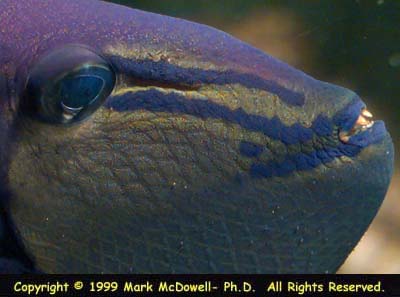|
|
Odonus Niger - The Purple
Wonder!!!
by
Mark McDowell, Ph.D. and Quinet Mitchell
This article is about one of our favorite marine fish, the Niger Trigger (Odonus Niger). This beautiful Triggerfish is one of the many different fish in the Balistidae Family. Other popular triggerfish are the clown triggerfish (Balistoides conspicillum), the Undulate Triggerfish (Balistapus undulatus) and the Queen Triggerfish ( Balistes vetula). The name Triggerfish was given because of the first dorsal fin that is used to lock the fish in place when it takes cover in between rocks or crevices.
|
|
It is almost impossible to dislodge a triggerfish once its trigger is in an erect position. The Niger Triggerfish is found mainly in the Indo Pacific and Red Sea.. There seems to be little difference in coloration from the two different regions. The coloration of the Niger Triggerfish seem to vary from blue to purple with many having a combination of the two. The most interesting feature in this triggerfish is the fact that the front teeth or fangs as many people call them, tend to have a reddish hue to them, hence the common name of Red-tooth triggerfish. Triggerfish can deliver a very painful bite easily drawing blood, so use caution if you must put your hand in the tank. Another feature of the Niger Triggerfish is that it has a lyre tail that can extend a few inches beyond the body reminding one of the Naso or Unicorn tang. They are extremely disease resistant and they have been known to survive the cycling period of a newly established aquarium (we would not recommend it). Triggerfish are also equipped with their own moving company, rearranging the tank decorations to suite their taste.
All Triggerfish have aggressive tendencies and the Niger is no exception. It is, however, tolerant of other fish in the closed aquarium and will get along peacefully with most species that are as large as it is. When adding any triggerfish to an already established aquarium, make sure that it is the smallest fish in the tank. The Niger is one of the least aggressive triggers and suitable tankmates should not be hard to find.
 |
 |
They are known to be incompatible with Blennies, Cardinalfishes, Dottybacks, Mandarinfishes, and Invertebrates.Triggerfish are not compatible with a reef aquarium and should be kept in a fish-only aquarium since they will eat crustaceans as well as some mobile and sessile invertebrates.
A variety of foods can be used to satisfy the nutritional requirements. Crustaceans, mollusks, fresh seafood, frozen seafood, vegetable matter and fortified flake food are enough to keep them healthy and growing. Niger Triggerfish can reach lengths of up to 20" in the wild and over 10" in the home aquarium. They can live over 10 years in the public or home aquarium and even longer in the wild. The general rule of thumb with any marine fish is 1" of fish for every 5 gallons of water which translates to a tank with a minimum of fifty gallons for a juvenile and at least 125 gallons for an adult.
After seeing an extremely large Niger Trigger at the Cleveland Metroparks Zoo, we immediately went home and started reading about this fish and decided to purchase one. The Niger Trigger photographed above is over 4 years old and we have watched it grow from just over 2" to over 7". The colors on this fish are magnificent and the fact that they can indeed be kept other fish is a plus. Niger Triggers should be fed at least twice a week with frozen krill, frozen seafood, and fortified flake food. Fresh Seafood should be used sparingly since they can quickly spoil and contaminate a tank if some is left uneaten.
If you are really interested in purchasing a Niger Triggerfish, we suggest you have an adequately sized aquarium, and feed it a wide variety of food and you can have years of enjoyment watching this spectacular fish grow. The next time you are in your pet store looking for a marine fish, take a good look at the Niger Triggerfish and give one a happy home.
|
|
Dr. P. V. Loiselle and Hans A. Baensch, Marine Aquarium Manual Comprehensive Edition,1991, pg. 250-254.
Nick Dakin, The book of the Marine Aquarium, 1992, pg. 174-179.
Dr. Warren E. Burgess, Dr. Herbert R. Axelrod and Ramond E. Hunziker III, Dr. Burgess Atlas of Marine Aquarium Fishes, 2nd edition, 1990, pg. 625, 627, 697.